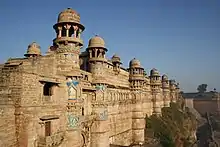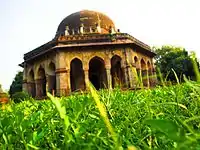Sikandar Lodi
Sikandar Lodi (died 21 November 1517), born Nizam Khan, was an Afghan Sultan of the Delhi Sultanate[1][2] between 1489 and 1517.[3] He became the next ruler of the Lodi dynasty after the death of his father Bahlul Lodi in July 1489.The second and most successful ruler of the Lodi dynasty of the Delhi sultanate, he was also a poet of the Persian language and prepared a diwan of 9000 verses.[4]
| Sikandar Lodhi | |
|---|---|
| Sultan of Delhi Sultan of the Lodi Dynasty | |
 The tomb of Sikandar Lodi | |
| Sultan of the Delhi Sultanate | |
| Reign | 17 July 1489 – 21 November 1517 |
| Coronation | 17 July 1489 |
| Predecessor | Bahlul Lodi |
| Successor | Ibrahim Lodi |
| Born | 17 July 1458 |
| Died | 21 November 1517 |
| Burial | |
| Issue | Ibrahim Lodi |
| Dynasty | Lodi dynasty |
| Father | Bahlul Lodi |
| Religion | Islam |
Biography

Sikandar was the second son of Sultan Bahlul Lodi, an Afghan ruler of Lodi Sultanate.[5]
Sikandar was a capable ruler who encouraged trade across his territory. He expanded Lodi territory into the regions of Gwalior and Bihar. He made a treaty with Alauddin Hussain Shah and his kingdom of Bengal. In 1503, he commissioned the building of the present-day city of Agra. Agra was founded by him.[6]
Conflict with Manasimha Tomar

The newly crowned Manasimha was not prepared for an invasion from Delhi, and decided to avoid a war by paying Bahlul Lodi a tribute of 800,000 tankas (coins).[7] In 1489, Sikandar Lodi succeeded Bahlul Lodi as the Sultan of Delhi. In 1500, Manasimha provided asylum to some rebels from Delhi, who had been involved in a plot to overthrow Sikandar Lodi. The Sultan, wanting to punish Manasimha, and to expand his territory, launched a punitive expedition against Gwalior. In 1501, he captured Dholpur, a dependency of Gwalior, whose ruler Vinayaka-deva fled to Gwalior.[8]
Sikandar Lodi then marched towards Gwalior, but after crossing the Chambal River, an epidemic outbreak in his camp forced him to halt his march. Manasimha used this opportunity to reconcile with Lodi, and sent his son Vikramaditya to the Lodi camp with gifts for the Sultan. He promised to expel the rebels from Delhi, on the condition that Dholpur be restored to Vinayaka-deva. Sikandar Lodi agreed to these terms, and left. Historian Kishori Saran Lal theorizes that Vinayaka Deva hadn't lost Dholpur at all: this narrative was created by the Delhi chroniclers to flatter the Sultan.[9]
In 1504, Sikandar Lodi resumed his war against the Tomaras. First, he captured the Mandrayal fort, located to the east of Gwalior.[9] He ransacked the area around Mandrayal, but many of his soldiers lost their lives in a subsequent epidemic outbreak, forcing him to return to Delhi.[6] Sometime later, Lodi moved his base to the newly established city of Agra, which was located closer to Gwalior. He captured Dholpur, and then marched against Gwalior, characterizing the expedition as a jihad. From September 1505 to May 1506, Lodi managed to ransack the rural areas around Gwalior, but was unable to capture the Gwalior fort because of Manasimha's hit-and-run tactics. A scarcity of food resulting from Lodi's destruction of crops forced Lodi to give up the siege. During his return to Agra, Manasimha ambushed his army near Jatwar, inflicting heavy casualties on the invaders.[10]
Having failed to capture the Gwalior fort, Lodi decided to capture the smaller forts surrounding Gwalior. Dholpur and Mandrayal were already in his control by this time. In February 1507, he captured the Uditnagar (Utgir or Avantgarh) fort lying on the Narwar-Gwalior route.[11] In September 1507, he marched against Narwar, whose ruler (a member of the Tomara clan) fluctuated his allegiance between the Tomaras of Gwalior and the Malwa Sultanate. He captured the fort after a year-long siege.[12] In December 1508, Lodi placed Narwar in charge of Raj Singh Kachchwaha, and marched to Lahar (Lahayer) located to the south-east of Gwalior. He stayed at Lahar for a few months, during which he cleared its neighbourhood of rebels.[12] Over the next few years, Lodi remained busy in other conflicts. In 1516, he made a plan to capture Gwalior, but an illness prevented him from doing so. Manasimha died in 1516, and Sikandar Lodi's illness also led to his death in November 1517.[13]
Religion
The Lodi Sultans were Muslims, and like their predecessors, acknowledged the authority of the Abbasid Caliphate over the Muslim World. Because Sikandar's mother was a Hindu, he tried to prove his Islamic credentials by resorting to strong Sunni orthodoxy as a political expediency. He destroyed Hindu temples, and under the pressure from the ulama, allowed the execution of a Brahmin who declared Hinduism to be as veracious as Islam. He also banned women from visiting the mazars (mausoleums) of Muslim saints, and banned the annual procession of the spear of the legendary Muslim martyr Salar Masud.[14]
Before Sikandar's time, the judicial duties in smaller villages and towns were performed by local administrators, while the Sultan himself consulted the scholars of the Islamic law (sharia). Sikandar established sharia courts in several towns, enabling the qazis to administer the sharia law to a larger population. Although such courts were established in areas with significant Muslim population, they were also open to non-Muslims, including for non-religious matters such as property disputes.[14]
References
- Chandra, Satish (2005). Medieval India: From Sultanat to the Mughals Part - II. Har-Anand Publications. ISBN 978-81-241-1066-9.
The first of these was the death of the Afghan ruler , Sikandar Lodi , at Agra towards the end of 1517 and the succession of Ibrahim Lodi . The second was the conquest of Bajaur and Bhira , by Babur in the frontier tract of north - west Punjab in ...
- Sengupta, Sudeshna. History & Civics 9. Ratna Sagar. p. 126. ISBN 9788183323642.
The Lodi dynasty was established by the Ghilzai tribe of the Afghans
- Sen, Sailendra (2013). A Textbook of Medieval Indian History. Primus Books. pp. 122–125. ISBN 978-9-38060-734-4.
- Ram Nath Sharma, History Of Education In India, Atlantic (1996), p. 61
- Lodī dynasty - Encyclopædia Britannica
- Kishori Saran Lal 1963, p. 176.
- Kishori Saran Lal 1963, p. 155.
- Kishori Saran Lal 1963, p. 174.
- Kishori Saran Lal 1963, p. 175.
- Kishori Saran Lal 1963, p. 177.
- Kishori Saran Lal 1963, pp. 177-178.
- Kishori Saran Lal 1963, p. 179.
- Kishori Saran Lal 1963, p. 184.
- J. S. Grewal (1998). The Sikhs of the Punjab. The New Cambridge History of India (Revised ed.). Cambridge University Press. p. 10. ISBN 978-0-521-63764-0.
Bibliography
- Kishori Saran Lal (1963). Twilight of the Sultanate. Asia Publishing House. OCLC 500687579.CS1 maint: ref=harv (link)
| Wikimedia Commons has media related to Sikandar Lodi. |
| Preceded by Bahlul Lodi |
Sultan of Delhi 1489–1517 |
Succeeded by Ibrahim Lodi |
